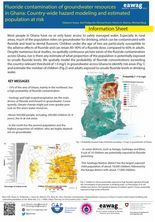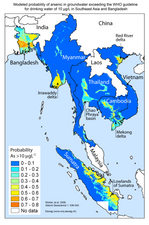Resources
Access and download our maps
Access to the repository of our global, national and regional maps, which you can download in high resolution....
December, 2022
How widespread is fluoride contamination of Ghana’s groundwater? (Information Sheet)

Most people in Ghana have no or only basic access to safely managed water. Especially in rural areas, much of the population relies on groundwater for drinking, which can be contaminated with fluoride and lead to dental fluorosis. Children under the age of two are particularly susceptible to the adverse effects of fluoride and can retain 80–90% of a fluoride dose, compared to 60% in adults. Despite numerous local studies, no spatially continuous picture exists of the fluoride contamination across Ghana, nor is there any estimate of what proportion of the population....
May 31, 2022
Groundwater Assessment Platform (GAP) flyer
Over 300 million people worldwide use groundwater as a source of drinking water that contains natural contaminants, (e.g. arsenic or Fuoride). The Swiss Federal Institute for Aquatic Science and Technology (Eawag) applies statistical and machine learning methods to estimate the risk of geogenic contamination using geological, topographical and further environmental data without having to test all groundwater wells. Corresponding risk maps of safe and unsafe groundwater were produced at regional to global scales....
December 04, 2019
Groundwater Assessment Platform (GAP) fact sheet
Over 300 million people worldwide use groundwater as a source of drinking water that is naturally contaminated with arsenic or fluoride. The Swiss Federal Institute of Aquatic Sciences and Technology (Eawag) has developed a methodology whereby the risk of contamination in a given area can be estimated using available geological, topographical and other environmental data without having to test groundwater sources....
January 06, 2020
Geogenic Contamination Handbook
This digital resource offers information and guidelines for practitioners dealing with arsenic- and fluoride-contaminated drinking water in developing countries.The handbook was revised and updated in June 2017. Download the updated version below. Note: because the handbook includes many embedded documents, it is a very large file (42 MB)! Individual chapters can be downloaded below. In addition, an online version of the handbook without embedded files is available via the Wiki page of....
December 04, 2019
GAP brochure
Groundwater serves as drinking water for around 50% of the world's population and is indispensable for irrigation and food production in many regions. Over-abstraction, pollution and changing climatic patterns are all factors leading to groundwater stress. In terms of drinking water quality, groundwater is usually less affected by pathogens than surface water. However, naturally occurring (geogenic) contaminants such as arsenic and fluoride affect many aquifers, with serious long-term health effects for those consuming the water.The Swiss Federal Institute for Aquatic Science and Technology (Eawag) has refined a method whereby the risk of geogenic contamination in a given area can be estimated using geological, topographical and other environmental data without having to test all groundwater wells. This knowledge is now available free of charge on the online Groundwater Assessment Platform (GAP)….
December 04, 2019
Risk Maps
The regional or national assessment of groundwater quality is vital when planning to exploit groundwater for drinking purposes. Especially in developing countries, detailed surveys on groundwater quality are often lacking or incomplete. Therefore, there is a demand for tools capable of assessing groundwater quality on larger scales, for example, to identify hot-spots for geogenic contamination. Using GIS methods, it is possible to model the probability of groundwater being contaminated by arsenic or fluoride on large scales¨(regional and global).
This approach combines raster data containing layers on geology, hydrology, soil types, climate and land use with point measurements of fluoride or arsenic in groundwater to investigate the possible relationship between these….
December 04, 2019
Water Resource Quality
Water Resource Quality (WRQ) was an integrated project running from 2006-2012 at Eawag that aimed to develop a generally applicable framework for the mitigation of geogenic contamination in groundwater used for drinking, in particular concerning arsenic and fluoride. We combined natural and social scientific expertise for the solution of a health problem that affects 100s of millions of people worldwide. The mitigation framework developed by the WRQ team from Eawag can help decision-makers and water resource managers to identify contaminated regions and to provide feasible options to help reduce the effects of contamination....
December 04, 2019
Groundwater Pollution Red River Delta/Vietnam
Groundwater Pollution Red River Delta/Vietnam Inorganic arsenic and manganese are the most widespread elemental contaminants of potable water around the world. Being mainly of natural (geogenic) origin, arsenic and manganese are released from sediments in the subsurface as a result of unfavourable geochemical conditions and can occur in groundwater at concentrations of more than 1000 micrograms per litre of water. The safety limits for arsenic in drinking water in most countries are 10 or 50 and, for manganese 400 micrograms per litre (µg/litre)....
December 04, 2019







